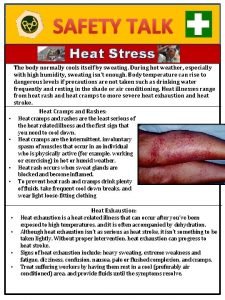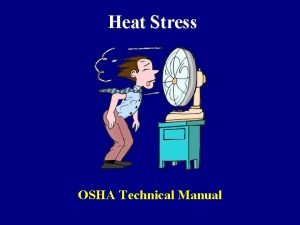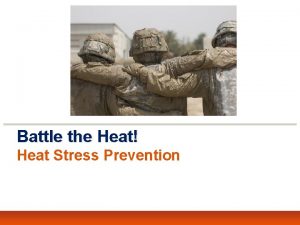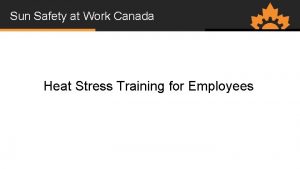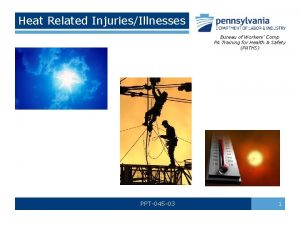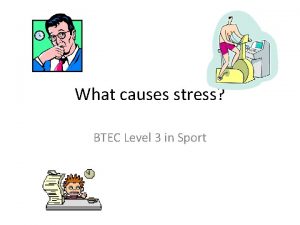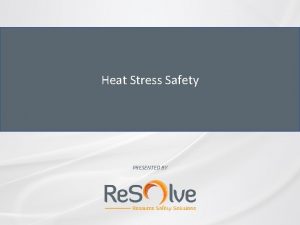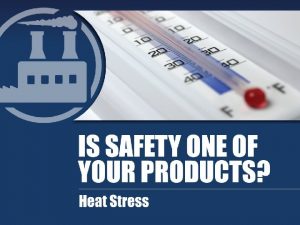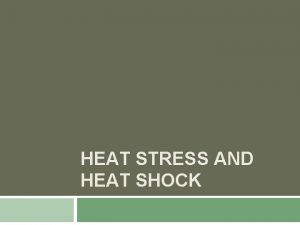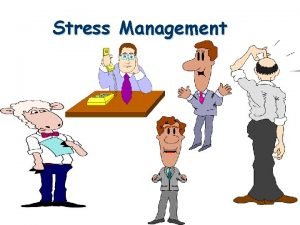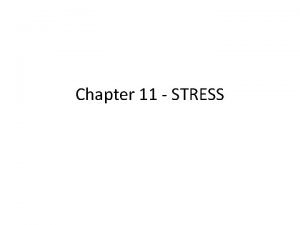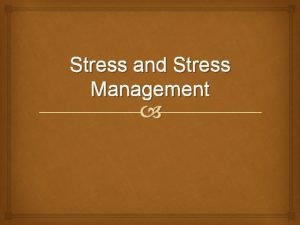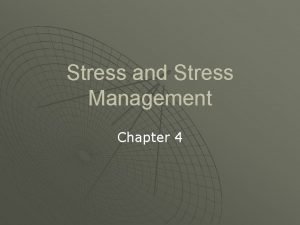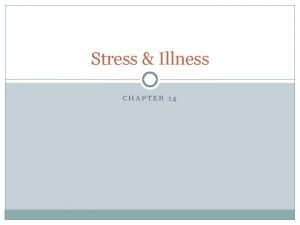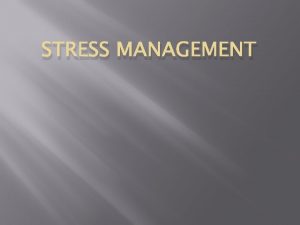Heat Stress Safety Heat Stress Safety Heat is



















- Slides: 19

Heat Stress Safety

Heat Stress Safety Heat is a leading cause of weather-related deaths, resulting in hundreds of deaths each year. Many workers are exposed to extreme heat conditions during the course of their work day, especially those doing heavy work tasks or using bulky or non-breathable protective clothing and equipment, and are at risk of heat stress. Heat stress can cause rashes, cramps, fainting, heat exhaustion and heat stroke. Extreme heat can also increase the risk of workers injuring themselves and others due to not being able to perform their work duties safely.

Definitions Understanding some terms will be helpful as you read this training booklet include: • Absolute Humidity - The amount of water vapor in the air divided by the amount of dry air. Water vapor is the gaseous state of water and is invisible. The hotter air is the more water vapor it can hold. • Relative Humidity - The most commonly used term regarding humidity. Expressed as a percent, measures the current absolute humidity compared to what the air can hold at that temperature. • Heat Index - An index that combines air temperature and relative humidity. The Heat Index, sometimes referred to as the apparent temperature, is a measure of how hot it really feels when relative humidity is factored in with the actual air temperature. • Saturation - The presence of the most water vapor possible in the air at a given temperature and pressure.

Body Cooling Systems The human body must maintain a constant internal core temperature of approximately 98. 6ºF. The body works naturally to maintain this temperature by generating heat, absorbing heat from the environment and releasing heat as needed. Environmental sources of heat include the ambient or surrounding air, sunlight, direct light, machinery and equipment to name a few. The body releases heat by varying the rate of blood circulation to and from the blood vessels near the extremities of the body. The blood carries heat from the body to the widened vessels near the body’s surface where it is released into the cooler atmosphere by one or more of the following ways: • Radiation - Body heat simply transfers to the air surrounding the body. Most effective at air temps below 80ºF

Body Cooling Systems • Convection - Heat is carried away by cooler air which passes over the skin. As with radiation, convection is most effective at temps below 80ºF • Evaporation - Water liquid, or sweat, is released from the sweat glands to the surface of the skin. Heat from the body changes the sweat into water vapor which then evaporates in warm, dry air. This process is known as a Phase Change and it has a tremendous cooling effect on the body’s temperature. Evaporation usually begins when the air temperature moves above 80ºF. Not all sweat has time to evaporate though and much of it tends to run off the body which does not cool the body.

Body Cooling Systems When it is extremely hot and humid the body’s ability to cool itself is affected. At air temperatures lower than 80ºF, radiation and convection are very effective methods of removing body heat. Once the air temperature reaches 80ºF those methods begin to lose their ability to cool the body. At 95°F, heat loss by radiation and convection stops completely. At this point, heat loss by sweating becomes extremely important. Sweating, without the Phase Change, does nothing to cool the body. Sweating is only effective if the humidity level is low enough to allow evaporation of water vapor into the air. As the humidity level increases, the amount of water vapor in the air increases. This decreases the “room” available for sweat to evaporate. It is also important for fluids and salt lost during sweating to be constantly replaced or dehydration can occur.

Heat Stress When the body heats too quickly to cool itself and/or when too much fluid or salt is lost through sweating or dehydration, the body starts to store excess heat. The core body temperature rises and the heart rate increases. This is heat stress! The stress brought on the body due to the excessive heat causes different symptoms which are referred to as heatrelated illnesses. These illnesses range from heat rash to heat exhaustion to heat stroke. Heat stroke can result in death and requires immediate medical help. Exposure to excessive heat can also increase the risk of injuries because of sweaty palms, foggy safety glasses, dizziness and burns from hot surfaces or steam.

Heat Stress Some risk factors of excessive body heat and stress include: • High air temperature and humidity • Direct sun exposure • Lack of air flow – no breeze, wind or ventilation • Radiant heat – heat which “radiates” from an element and heats the body. Boilers, furnaces and other hot production machinery and equipment • Physical exertion – the body creates heat known as metabolic heat. The more strenuous the work, the more heat produced. • PPE – bulky or non-breathable personal protective equipment • Acclimation – lack of previous exposure to the hot work environment • Poor physical condition or health problems • Prescription drug and alcohol use • Age • Previous heat-related illness • Sunburn – can greatly retard the skins ability to release heat

Heat-Related Illnesses and Treatment Excessive exposure to heat stress can lead to a wide range of heat-related illnesses. Generally, symptoms start out mild and get worse, if not treated. Tolerance to heat stress varies from worker to worker but usually all workers will exhibit reduced mental and physical performance as heat stress starts to affect them. Here are the most common heat-related illnesses and steps to take for treatment. Heat Rash – Heat rash, also known as prickly heat, is the most common heat stress problem. It is caused by excessive sweating and looks like a red cluster of pimples or small blisters. Usually appears on the neck, upper chest, groin, under the breast and in elbow creases. The best treatment is to provide a cooler, less humid work area. Keep the rash dry and use powder to provide comfort. Do not use creams or ointments that make the skin moist and warm.

Heat-Related Illnesses and Treatment Heat Cramps - Muscle pains usually created by physical work in hot environments are called heat cramps. They are caused by the loss of salt and fluids during sweating and generally occur in legs, abdomen, and arms. Treat heat cramps by stopping work activity and replacing fluid loss. Sit in a cool place and drink water and/or sports drinks, which replace electrolytes. Avoid strenuous work for a couple of hours until the cramps have totally subsided. Heat Syncope or Fainting - Heat syncope is a fainting episode or dizziness that usually occurs with prolonged standing or sudden rising from a sitting or lying position. Factors which may contribute to heat syncope include dehydration and lack of acclimatization. Sit or lie down in a cool place. Drink water, clear juice or a sports drink.

Heat-Related Illnesses and Treatment Heat Exhaustion – Brought on by a large loss of liquids and salt due to excessive sweating. Symptoms include heavy sweating, headache, nausea, vomiting, dizziness, weakness, irritability, confusion, thirst, and a body temperature greater than 100. 4ºF. Treating heat exhaustion is important. If not treated it could lead to heat stroke which is very dangerous and life threatening. Move to a cool place inside or in the shade. Lie down and loosen clothing. Drink cool water or if available some type of sports drink. Avoid caffeine and alcohol, as these will make the condition worse. Eating a salty food such as a saltine is beneficial, if available. Massage and stretch muscles. Take a cool bath or shower. If person is vomiting or fainting, or if after 30 minutes of treatment there is no relief, medical help should be contacted immediately.

Heat-Related Illnesses and Treatment Heat Stroke – This is the most serious heat-related health illness. Heat stroke is very dangerous and can cause organ or brain damage and even death. Usually, heat stroke progresses from a milder condition such as heat exhaustion and is generally brought about by an extremely high heat index (extreme heat combined with high humidity) and dehydration. It occurs when the body’s temperature regulating system fails and the body temperature rises to 105ºF or higher. The symptoms of heat stroke are confusion, loss of consciousness, seizures, slurred speech and a throbbing headache. Skin may be hot and dry or could be sweating profusely. This is a medical emergency which could result in death. Call 91 -1 and get trained medical help immediately. Until medical help arrives move the worker to a cool spot in the shade or an air-conditioned building and remove as much clothing as possible. Soak the body with cool water from a garden hose or other source and fan the air around them. Apply ice packs to the neck, armpits and groin area to assist the body in cooling down. Provide sips of cool water or other nonalcoholic beverage if they are able to drink it.

Heat Index The risk of heat-related illness becomes greater for outdoor workers as the weather gets hotter and more humid. For people working outdoors in hot weather, both air temperature and humidity affect how hot they feel. The higher the heat index, the hotter the weather feels, since sweat does not readily evaporate and cool the skin. The heat index is a better measure than air temperature alone for estimating the risk to workers from environmental heat sources. The heat index can be used to help determine what actions are needed to protect workers, and when those actions are triggered. It does not account for certain conditions that contribute additional risk, such as physical exertion and wearing heavy or protective clothing. Also, working in direct sunlight can add up to 15°F to the heat index value.

Prevention and Protection Most heat-related problems can be avoided or the risk of developing them reduced. As an employee, you should take heat stress seriously and do what you can to protect your health as well as your coworkers. Instead of having to respond to a heat-related medical emergency, it is best to evaluate all jobs for possible heat stress risk and then take action to minimize the risk. This can be accomplished through engineering controls, work practices and PPE.

Prevention and Protection Engineering Controls The best way to prevent heat-related illness is to make the work environment cooler. This can be accomplished through Engineering Controls. When working outdoors schedule work activities during the cooler part of the day in the early mornings if possible. Take frequent breaks in shaded areas. Tents can be used to provide shade from the sun. Air conditioned trailers should be available for lunch breaks and other breaks. Use equipment with air conditioned cabs if possible. A reduced workload can provide relief from the heat as well as reducing physical exertion through the use of power tools and machinery. When working inside utilize the following: • Air conditioned areas for work and for breaks • Fans and ventilation systems to increase air flow • Portable cooling fans • Local exhaust ventilation at points of high heat production or moisture • Reflective shields to redirect radiant heat • Insulate hot surfaces

Prevention and Protection Work Practices There are Work Practices which should be in place for you to follow. The first and best step is for employees to be trained about the dangers of excessive heat and humidity and ways to avoid heat stress. An acclimation period of at least five days is necessary to allow the body to adjust to the hot work environment. New workers and those returning from an absence of two weeks or more should have a 5 -day minimum adjustment period. While a significant amount of acclimatization occurs rapidly in that first week, full acclimatization may take a little longer. Some workers require up to two or three weeks to fully acclimatize.

Prevention and Protection An ample supply of cool drinking water should be available at all times. Workers must drink water throughout the day to keep their body hydrated. During moderate work levels in moderate heat conditions, drink at least one pint of water per hour. It is best to drink a 6 ounce cup of water about every 15 minutes. Be aware it is harmful to drink excessive amounts of water. Workers should generally not drink more than 12 quarts of fluid in 24 hours. Avoid alcohol and drinks with large amounts of sugar and caffeine. If properly hydrated urine should be clear or lightly colored. Check weather forecast daily to be better prepared. Schedule jobs with high heat exposure to cooler times of the day or even different times of the year if possible. Routine maintenance and repair tasks could generally be scheduled during cooler seasons. In addition wear light-colored, loose-fitting clothing made from cotton. Do not wear clothing made from non-breathing synthetic material.

Prevention and Protection Personal Protective Equipment (PPE) The use of some PPE, such as certain types of respirators and fire resistant clothing, can increase the risk of heat stress. Workers should be monitored by establishing a routine to periodically check them for signs of overexposure. In other situations, special cooling devices can protect workers in hot environments. Some examples of heat protection PPE include insulated gloves and suits, reflective clothing, infrared reflective face shields and thermally conditioned clothing.

Conclusion Heat stress is not something to take lightly. When working in areas where you are exposed to high temperatures and high humidity be cautious. Allow yourself time to acclimate to your surroundings, drink plenty of fluids and take rest breaks in a cool shaded area. Seek help at the first sign of any heat related illness.
 Heat stress safety talk
Heat stress safety talk True
True Axial stress vs normal stress
Axial stress vs normal stress Chapter 10 stress responses and stress management
Chapter 10 stress responses and stress management I shaped beam
I shaped beam Osha technical manual
Osha technical manual Heat stress photos
Heat stress photos What is heat stress
What is heat stress Heat stress definition
Heat stress definition Ecdis safety settings
Ecdis safety settings Safety care behavioral safety training
Safety care behavioral safety training Process safety vs personal safety
Process safety vs personal safety Safety assessment for ind safety reporting
Safety assessment for ind safety reporting Basic safety construction site safety orientation
Basic safety construction site safety orientation Basic safety construction site safety orientation
Basic safety construction site safety orientation Properties of heat
Properties of heat Specific latent heat formula
Specific latent heat formula Principle of cooking
Principle of cooking Personal causes of stress in sport
Personal causes of stress in sport Les types de stress
Les types de stress
